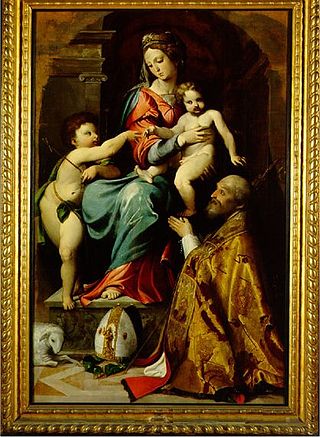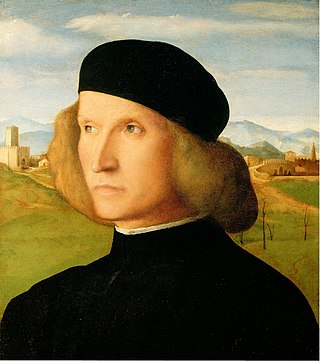
Benedetto Bembo (c. 1423 - 1489) was an Italian painter and miniaturist.

Benedetto Bembo (c. 1423 - 1489) was an Italian painter and miniaturist.
Details of Bembo's life are scarce. He was likely born in Brescia, the son of one Giovanni from Cremona and the brother of painter Bonifacio Bembo.
His first known work is the Torrechiara Polyptich, of 1462, once housed in the San Nicodemo Chapel of the Castle of Torrechiara and later moved in the Art Gallery of the Castello Sforzesco in Milan. Bembo was also responsible of the decoration of the Camera d'Oro ("Golden Chamber") in the same castle: it is a fresco cycle, dating from around 1462, telling the amorous deeds of condottiero Pier Maria II de' Rossi (then owner of the building) and his lover Bianca Pellegrini. Another work is a panel of Madonna of Humility and Musician Angels (c. 1460) now in the Civic Museum Amedeo Lia of La Spezia.

Pietro Bembo, O.S.I.H. was a Venetian scholar, poet, and literary theorist who also was a member of the Knights Hospitaller, and a cardinal of the Catholic Church. As an intellectual of the Italian Renaissance, Pietro Bembo greatly influenced the development of the Tuscan dialect as a literary language for poetry and prose, which, by later codification into a standard language, became the modern Italian language. In the 16th century, Bembo's poetry, essays and books proved basic to reviving interest in the literary works of Petrarch. In the field of music, Bembo's literary writing techniques helped composers develop the techniques of musical composition that made the madrigal the most important secular music of 16th-century Italy.
This article is a list of the literary events and publications in the 15th century.
This article contains information about the literary events and publications of 1502.

Saluzzo is a town and former principality in the province of Cuneo, in the Piedmont region, Italy.
This article lists the most significant events and works of the year 1720 in music.

Vincenzo Foppa was an Italian painter from the Renaissance period. While few of his works survive, he was an esteemed and influential painter during his time and is considered the preeminent leader of the Early Lombard School. He spent his career working for the Sforza family, Dukes of Milan, in Pavia, as well as various other patrons throughout Lombardy and Liguria. He lived and worked in his native Brescia during his later years.

Saint Sebastian is the subject of three paintings by the Italian Early Renaissance master Andrea Mantegna. The Paduan artist lived in a period of frequent plagues; Sebastian was considered protector against the plague as he had been shot through by arrows, and it was thought that plague spread abroad through the air.

Giuliano da Maiano (1432–1490) was an Italian architect, intarsia-worker, and sculptor, the elder brother of Benedetto da Maiano, with whom he often collaborated.

Bonifacio Bembo, also called Bonfazio Bembo, or simply just Bembo, was a north Italian Renaissance artist born in Brescia in 1420. He was the son of Giovanni Bembo, an active painter during his time. As a painter, Bonifacio mainly worked in Cremona. He was patronized by the Sforza family and was commissioned to paint portraits of Francesco Sforza and his wife Bianca Maria Visconti. Scholars have credited him as the artist who produced a tarot card deck for the Visconti-Sforza families, now held in the Cary Collection of Playing Cards at Yale University. In the past century, art historians have begun to question the authenticity of his works, believing his only two secure works to be the portraits of Francesco and Bianca Maria Sforza. He is believed to have died sometime before 1482.

Giovanni Francesco Bembo was an Italian Renaissance painter from Cremona, mainly active from 1515 to 1543. He apprenticed with Boccaccio Boccaccino. In 1515, he painted two frescoes: Presentation in the Temple and an Adoration of the Magi for the Duomo of Cremona. He painted an altarpiece for San Pietro depicting a Madonna with three saints and a donor in 1524. In 1530, he painted a Madonna with Saint Stephen and in 1540, a Madonna with St. John the Baptist and a Bishop now in the Museo Civico.

Torrechiara Castle is a 15th-century castle near Langhirano, in the province of Parma, northern Italy. It sits atop a terraced hill south of the city of Parma, in a strategic position overlooking the Parma River in the valley below. The castle was commissioned by Pier Maria II de' Rossi, the fourth count of San Secondo, and built between 1448 and 1460. The fortress shows the influence of the castles of the House of Sforza, particularly Visconti-Sforza Castle. The castle is managed by the Polo Museale dell'Emilia Romagna since 2015.
The decade of the 1460s in art involved some significant events.

The Death of the Virgin is a painting by the Italian Renaissance painter Andrea Mantegna, dating to c. 1462–1464.
The bailo and captain of Negroponte was the representative of the Republic of Venice stationed at Chalcis (Negroponte) on the island of Euboea. The bailo played an important role as the mediator between, and de facto overlord of, the triarchs of Euboea, who had their common residence in Negroponte. The triarchies were created by the division of the island between three rulers (triarchs) after its conquest following the Fourth Crusade (1204).

Benedetto Pesaro was a Venetian nobleman who served as commander-in-chief of the Venetian navy from 1500 to 1503. He is notable for his military successes during the Second Ottoman–Venetian War.

Portrait of a Young Man is a c.1505 oil-on-panel painting by the Italian painter Giovanni Bellini. It is the latest surviving portrait by the artist, drawing on the work of Antonello da Messina and Dutch painters of the time. It is also the only portrait in which he included a landscape behind the sitter. He signed it on a cartouche on the trompe-l'œil marble parapet in the foreground.
Guido de' Rossi was an Italian condottiero.
Arturo Carlo Quintavalle is an Italian art historian, critic and academic. He was professor of art history at Parma University and founded and for several years headed that university's Centro Studi e Archivio della Comunicazione.

Bernardo Bembo was a Venetian humanist, diplomat and statesman. He was the father of Pietro Bembo.